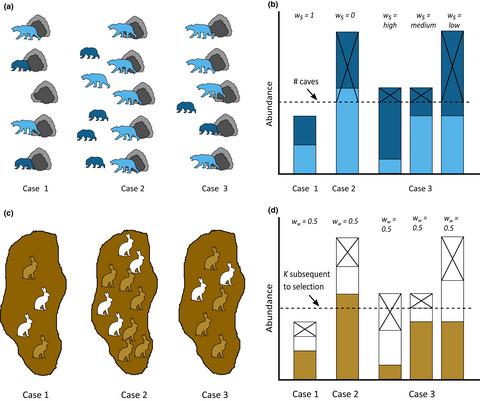当前位置:
X-MOL 学术
›
Ecol. Lett.
›
论文详情
Our official English website, www.x-mol.net, welcomes your feedback! (Note: you will need to create a separate account there.)
The ecological causes and consequences of hard and soft selection
Ecology Letters ( IF 8.8 ) Pub Date : 2021-04-30 , DOI: 10.1111/ele.13754 Donovan A. Bell 1 , Ryan P. Kovach 2 , Zachary L. Robinson 1 , Andrew R. Whiteley 1 , Thomas E. Reed 3, 4
Ecology Letters ( IF 8.8 ) Pub Date : 2021-04-30 , DOI: 10.1111/ele.13754 Donovan A. Bell 1 , Ryan P. Kovach 2 , Zachary L. Robinson 1 , Andrew R. Whiteley 1 , Thomas E. Reed 3, 4
Affiliation

|
Interactions between natural selection and population dynamics are central to both evolutionary-ecology and biological responses to anthropogenic change. Natural selection is often thought to incur a demographic cost that, at least temporarily, reduces population growth. However, hard and soft selection clarify that the influence of natural selection on population dynamics depends on ecological context. Under hard selection, an individual's fitness is independent of the population's phenotypic composition, and substantial population declines can occur when phenotypes are mismatched with the environment. In contrast, under soft selection, an individual's fitness is influenced by its phenotype relative to other interacting conspecifics. Soft selection generally influences which, but not how many, individuals survive and reproduce, resulting in little effect on population growth. Despite these important differences, the distinction between hard and soft selection is rarely considered in ecology. Here, we review and synthesize literature on hard and soft selection, explore their ecological causes and implications and highlight their conservation relevance to climate change, inbreeding depression, outbreeding depression and harvest. Overall, these concepts emphasise that natural selection and evolution may often have negligible or counterintuitive effects on population growth—underappreciated outcomes that have major implications in a rapidly changing world.
中文翻译:

硬选择和软选择的生态原因和后果
自然选择和种群动态之间的相互作用是进化生态学和生物对人为变化的反应的核心。自然选择通常被认为会产生人口成本,至少暂时会减少人口增长。然而,硬选择和软选择阐明了自然选择对种群动态的影响取决于生态环境。在硬选择下,个体的适应度与种群的表型组成无关,当表型与环境不匹配时,种群数量会大幅下降。相比之下,在软选择下,个体的适应度受其相对于其他相互作用的同种物种的表型的影响。软选择通常会影响哪些个体生存和繁殖,但不会影响多少个体,对人口增长影响不大。尽管存在这些重要差异,但生态学中很少考虑硬选择和软选择之间的区别。在这里,我们回顾和综合关于硬选择和软选择的文献,探索它们的生态原因和影响,并强调它们与气候变化、近交衰退、远交衰退和收获的保护相关性。总体而言,这些概念强调自然选择和进化对人口增长的影响通常可以忽略不计或违反直觉——被低估的结果在快速变化的世界中具有重大影响。我们回顾和综合关于硬选择和软选择的文献,探索它们的生态原因和影响,并强调它们与气候变化、近交衰退、远交衰退和收获的保护相关性。总体而言,这些概念强调自然选择和进化对人口增长的影响通常可以忽略不计或违反直觉——被低估的结果在快速变化的世界中具有重大影响。我们回顾和综合关于硬选择和软选择的文献,探索它们的生态原因和影响,并强调它们与气候变化、近交衰退、远交衰退和收获的保护相关性。总体而言,这些概念强调自然选择和进化对人口增长的影响通常可以忽略不计或违反直觉——被低估的结果在快速变化的世界中具有重大影响。
更新日期:2021-06-13
中文翻译:

硬选择和软选择的生态原因和后果
自然选择和种群动态之间的相互作用是进化生态学和生物对人为变化的反应的核心。自然选择通常被认为会产生人口成本,至少暂时会减少人口增长。然而,硬选择和软选择阐明了自然选择对种群动态的影响取决于生态环境。在硬选择下,个体的适应度与种群的表型组成无关,当表型与环境不匹配时,种群数量会大幅下降。相比之下,在软选择下,个体的适应度受其相对于其他相互作用的同种物种的表型的影响。软选择通常会影响哪些个体生存和繁殖,但不会影响多少个体,对人口增长影响不大。尽管存在这些重要差异,但生态学中很少考虑硬选择和软选择之间的区别。在这里,我们回顾和综合关于硬选择和软选择的文献,探索它们的生态原因和影响,并强调它们与气候变化、近交衰退、远交衰退和收获的保护相关性。总体而言,这些概念强调自然选择和进化对人口增长的影响通常可以忽略不计或违反直觉——被低估的结果在快速变化的世界中具有重大影响。我们回顾和综合关于硬选择和软选择的文献,探索它们的生态原因和影响,并强调它们与气候变化、近交衰退、远交衰退和收获的保护相关性。总体而言,这些概念强调自然选择和进化对人口增长的影响通常可以忽略不计或违反直觉——被低估的结果在快速变化的世界中具有重大影响。我们回顾和综合关于硬选择和软选择的文献,探索它们的生态原因和影响,并强调它们与气候变化、近交衰退、远交衰退和收获的保护相关性。总体而言,这些概念强调自然选择和进化对人口增长的影响通常可以忽略不计或违反直觉——被低估的结果在快速变化的世界中具有重大影响。


























 京公网安备 11010802027423号
京公网安备 11010802027423号